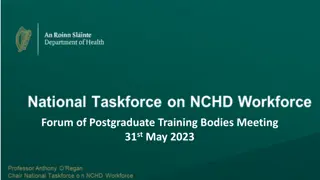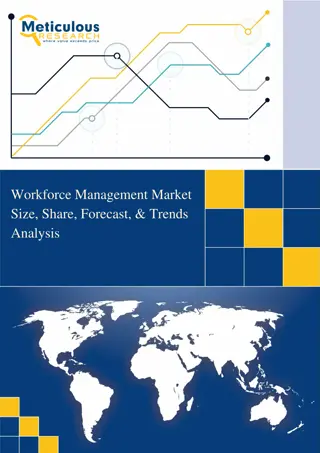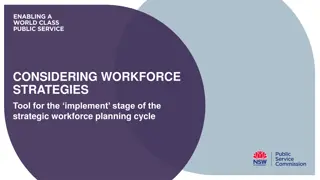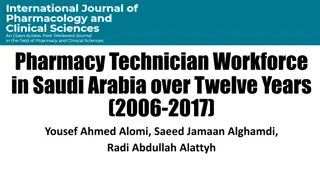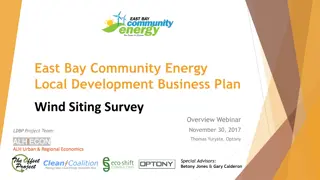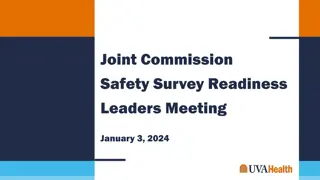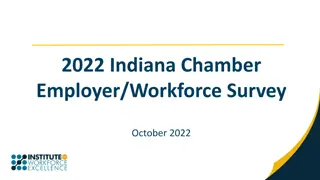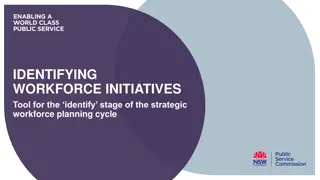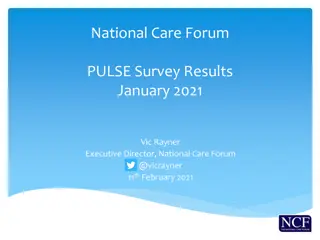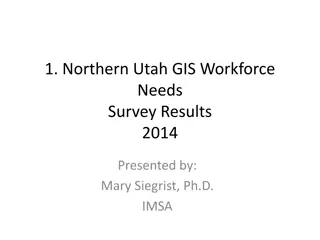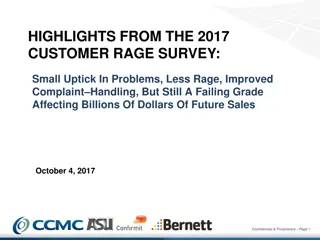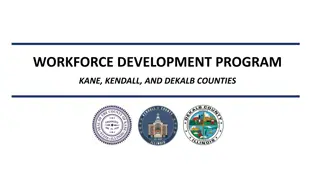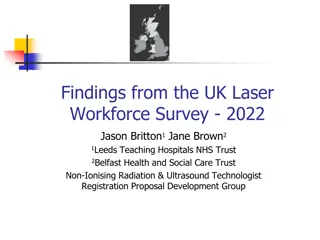Workforce Survey 2017
This data from the Workforce Survey 2017 shows the impact of statutory changes like the National Living Wage, Apprenticeship Levy, Immigration Skills Charge, and Pensions Auto-Enrolment on businesses' overall cost base. It includes the percentage of businesses reporting an increase in costs and those noting no increase, highlighting differences across sectors such as B2C and B2B.
Download Presentation

Please find below an Image/Link to download the presentation.
The content on the website is provided AS IS for your information and personal use only. It may not be sold, licensed, or shared on other websites without obtaining consent from the author.If you encounter any issues during the download, it is possible that the publisher has removed the file from their server.
You are allowed to download the files provided on this website for personal or commercial use, subject to the condition that they are used lawfully. All files are the property of their respective owners.
The content on the website is provided AS IS for your information and personal use only. It may not be sold, licensed, or shared on other websites without obtaining consent from the author.
E N D
Presentation Transcript
Workforce Survey 2017 August 2017
[q8] Relative to your overall cost base, what impact have the following statutory changes had on your business? NATIONAL LIVING WAGE 1% 21% 50% reporting increase in costs Significant increase in costs Slight increase in costs 49% No increase in costs Don't know 29% [q8] Relative to your overall cost base, what impact have the following statutory changes had on your business? Workforce Survey 2017 BASE: (Total: N = 1403)
[q8] Relative to your overall cost base, what impact have the following statutory changes had on your business? APPRENTICESHIP LEVY 4% 11% 16% 20% reporting increase in costs Significant increase in costs Slight increase in costs No increase in costs Don't know 69% [q8] Relative to your overall cost base, what impact have the following statutory changes had on your business? Workforce Survey 2017 BASE: (Total: N = 1351)
[q8] Relative to your overall cost base, what impact have the following statutory changes had on your business? IMMIGRATION SKILLS CHARGE 3% 5% 20% 8% reporting increase in costs Significant increase in costs Slight increase in costs No increase in costs Don't know 72% [q8] Relative to your overall cost base, what impact have the following statutory changes had on your business? Workforce Survey 2017 BASE: (Total: N = 1346)
[q8] Relative to your overall cost base, what impact have the following statutory changes had on your business? PENSIONS AUTO-ENROLMENT 3% 23% 22% 75% reporting increase in costs Significant increase in costs Slight increase in costs No increase in costs Don't know 52% [q8] Relative to your overall cost base, what impact have the following statutory changes had on your business? Workforce Survey 2017 BASE: (Total: N = 1386)
Costs by sector 73% of B2C reporting increase in costs compared to 41% of B2B [q8] Relative to your overall cost base, what impact have the following statutory changes had on your business? Workforce Survey 2017 BASE: (Total: N = 1386)
55% and 51% of respondents in North and Midlands reporting increase in costs, respectively. 43% of respondents in the South reporting increase in costs. [q8] Relative to your overall cost base, what impact have the following statutory changes had on your business? Workforce Survey 2017 BASE: (Total: N = 1386)
[q10] What ways, if any, would your business respond to such increases in the National Living Wage over the next 3 years? Raise prices of products and services 38% My business will not take any action 35% Reduce pay growth for staff 25% Reduce staff benefits such as bonuses, overtime, etc. 21% Scale back recruitment 20% Recruit workers on flexible working contracts (e.g. self- 15% Reduce hours worked by staff 14% Increase investment in automation 14% Scale back investment/growth plans 13% Recruit more workers aged under 25 and/or apprentices 11% Redundancies 8% Reduce staff training budget 8% Other, please specify 7% Reduce pension contributions 4% 0% 5% 10% 15% 20% 25% 30% 35% 40% [q10] What ways, if any, would your business respond to such increases in the National Living Wage over the next 3 years? Workforce Survey 2017 BASE: (Total: N = 1387)
[q11] Does your firms pay bill exceed 3m? 1% 10% Yes No Don't know 89% [q11] Does your firm s pay bill exceed 3m? Workforce Survey 2017 BASE: (Total: N = 1427)
[q12] In the last 12 months, has your business recruited apprentices? Yes 29% Don t know No 71% No Yes Don t know 0% 0% 10% 20% 30% 40% 50% 60% 70% 80% [q12] In the last 12 months, has your business recruited apprentices? Workforce Survey 2017 BASE: (Total: N = 1427)
[q14] Do you expect to recover the Apprenticeship Levy amount spent by your company? I.e. by training sufficient apprentices to recoup the amount levied Yes, we expect to recover more than our Levy payment 15% Yes, we expect to recover 100% of our Levy payment 21% We expect to partially recover our Levy payment 41% We don t expect to recover any of our Levy payment 15% Have limited or no understanding of the Apprenticeship Levy 5% Other, please specify 3% 0% 5% 10% 15% 20% 25% 30% 35% 40% 45% BASE: (Do you expect to recover the Apprenticeship Levy amount spent by your company? I.e. by training sufficient apprentices to recoup the amount levied: N = 137) Workforce Survey 2017
[q15] What changes, if any, will your business make as a direct response to the introduction of the Apprenticeship Levy? Don t know 36% Have limited or no understanding of the Apprenticeship Levy 25% Other, please specify 15% Continue existing apprenticeship programmes and pay the 10% contribution 8% Recruit more apprentices 7% Begin new apprenticeship training programme 6% Convert some or all existing training or graduate schemes into apprenticeship programmes 5% Close existing training delivery arm or training company 1% Establish a new training delivery arm or training company 1% Transfer up to 10% of the levy to employers in your supply chain 0% 0% 5% 10% 15% 20% 25% 30% 35% 40% [q15] What changes, if any, will your business make as a direct response to the introduction of the Apprenticeship Levy? Workforce Survey 2017 BASE: (Total: N = 1321)
[q8] Relative to your overall cost base, what impact have the following statutory changes had on your business? Workforce Survey 2017 BASE: (Total: N = 1386)
[q16] Over the past 12 months, has your business faced skills or labour shortages? Yes 48% No 51% Don't know 0% 0% 10% 20% 30% 40% 50% 60% [q16] Over the past 12 months, has your business faced skills or labour shortages? Workforce Survey 2017 BASE: (Total: N = 1411)
[q17] Over the past 12 months, how has your business sought to address skills or labour shortages shortages? Increased investment in recruitment 35% Increased investment in training 31% Increased pay and benefits 29% Used self-employed workers/contractors 26% Retained older workers 24% Outsourced work to other companies 22% Developed relationship/pipeline with local 21% Increased investment in automation 15% Used inter-company transfers of staff 10% Targeted recruitment of non-UK nationals overseas 8% Downsized or significantly changed business model 7% Other, please specify 6% No action taken 5% Relocated business partially or completely overseas 3% Don t know 1% 0% 5% 10% 15% 20% 25% 30% 35% 40% [q17] Over the past 12 months, how has your business sought to address skills or labour shortages shortages? Workforce Survey 2017 BASE: (Total: N = 676)
[q18] Which of the following approaches does your business typically take to fill job vacancies? Word of mouth 51% Post job adverts to online job search website 43% Use recruitment agencies based in the UK 40% Post job adverts to company website 36% Contact JobCentre 18% Advertise in local newspaper 16% Other, please specify 10% None of these 8% Advertise in trade publication or national newspaper 7% Use recruitment agencies based outside UK, but elsewhere in EU 2% Use recruitment agencies based outside EU 1% Don t know 0% 0% 10% 20% 30% 40% 50% 60% [q18] Which of the following approaches does your business typically take to fill job vacancies? Workforce Survey 2017 BASE: (Total: N = 1395)
[q19] Approximately what percentage of job applications for roles within your company come from the EU or rest of the world? 70% 60% 50% 40% EU nationals (i.e. non-UK) Non-EU nationals (i.e. rest of the world) 30% 20% 10% 0% 0% 1-9% 10-19% 20-49% 50-79% 80-100% Don't know [q19] Approximately what percentage of job applications for roles within your company come from the EU or rest of the world? BASE: (EU nationals (i.e. non-UK): N = 1354;Non-EU nationals (i.e. rest of the world): N = 1232) Workforce Survey 2017
[q20a] Approximately what percentage of your organisation's employees are from other EU countries (i.e. non-UK)? 0% 59% 1-9% 22% 10-19% 8% 20-49% 6% 50-79% 3% 80-100% 2% Don't know 1% 0% 10% 20% 30% 40% 50% 60% 70% [q20a] Approximately what percentage of your organisation's employees are from other EU countries (i.e. non-UK)? Workforce Survey 2017 BASE: (Total: N = 1387)
[q20b] Approximately what percentage of your organisation's employees are from outside the EU (i.e. rest of the world)? 0% 76% 1-9% 17% 10-19% 4% 20-49% 2% 50-79% 1% 80-100% 0% Don't know 1% 0% 10% 20% 30% 40% 50% 60% 70% 80% [q20b] Approximately what percentage of your organisation's employees are from outside the EU (i.e. rest of the world)? Workforce Survey 2017 BASE: (Total: N = 1379)
[q21] How would you describe the skill levels of the non-UK employees in your business? Professional/managerial 37% Skilled manual/technical 42% Clerical/administrative 23% Un-/semi-skilled 35% Don't know 2% 0% 5% 10% 15% 20% 25% 30% 35% 40% 45% [q21] How would you describe the skill levels of the non-UK employees in your business? Workforce Survey 2017 BASE: (Total: N = 608)
[q22] What impact, if any, would any future restriction on the rights of EU nationals to work in the UK to have on your business? Significant positive impact 2% Slight positive impact 2% No impact 54% Slight negative impact 21% Significant negative impact 17% Don't know 5% 0% 10% 20% 30% 40% 50% 60% [q22] What impact, if any, would any future restriction on the rights of EU nationals to work in the UK to have on your business? Workforce Survey 2017 BASE: (Total: N = 1376)
[q22] What impact, if any, would any future restriction on the rights of EU nationals to work in the UK to have on your business? [q23] How would your business respond, if at all, to any potential future restriction on the rights of EU nationals to work in the UK? Workforce Survey 2017 BASE: (Total: N = 1354)
[q23] How would your business respond, if at all, to any potential future restriction on the rights of EU nationals to work in the UK? My business would not be affected 43% Focus recruitment on UK workers 20% Don t know 15% Plan to retain older employees 9% Focus recruitment on apprentices 8% Relocate business partially or complete overseas 7% Pay additional costs to recruit from the EU (if this is possible) 6% Focus recruitment on non-EU (rest of the world) workers 6% Invest more in training 6% Downsize or significantly change business model 6% Other, please specify 4% 0% 5% 10% 15% 20% 25% 30% 35% 40% 45% 50% [q23] How would your business respond, if at all, to any potential future restriction on the rights of EU nationals to work in the UK? Workforce Survey 2017 BASE: (Total: N = 1354)
[q24] Approximately what is the average age of employees in your workforce? 16-21 0% 22-30 9% 31-40 37% 41-50 36% 51-60 12% 60-65 2% Over 65 1% Don't know 2% 0% 5% 10% 15% 20% 25% 30% 35% 40% [q24] Approximately what is the average age of employees in your workforce? Workforce Survey 2017 BASE: (Total: N = 1367)
[q25] Considering the past five years, has there been a change in the number of staff in your business working flexibly (e.g. from home or other remote locations) during work days? 40% of respondents report an increase in the number of staff working flexibly Significant increase 9% Slight increase 31% No increase nor decrease 56% Slight decrease 2% Significant decrease 1% Don t know 1% 0% 10% 20% 30% 40% 50% 60% [q25] Considering the past five years, has there been a change in the number of staff in your business working flexibly (e.g. from home or other remote locations) during work days? Workforce Survey 2017 BASE: (Total: N = 1356)
[q25] Considering the past five years, has there been a change in the number of staff in your business working flexibly (e.g. from home or other remote locations) during work days? 48% of B2B firms report an increase in flexible/remote working compared to 34% of manufacturers and 24% of B2C firms [q25] Considering the past five years, has there been a change in the number of staff in your business working flexibly (e.g. from home or other remote locations) during work days? Workforce Survey 2017 BASE: (Total: N = 1356)
[q26] Does your business have a stated policy to actively reduce business travel (e.g. through the use of videoconferencing or remote working)? Yes 25% No 74% Don't know 1% 0% 10% 20% 30% 40% 50% 60% 70% 80% [q26] Does your business have a stated policy to actively reduce business travel (e.g. through the use of videoconferencing or remote working)? Workforce Survey 2017 BASE: (Total: N = 1354)
[q26] Does your business have a stated policy to actively reduce business travel (e.g. through the use of videoconferencing or remote working)? B2B firms far more likely to have a stated policy to actively reduce business travel [q26] Does your business have a stated policy to actively reduce business travel (e.g. through the use of videoconferencing or remote working)? Workforce Survey 2017 BASE: (Total: N = 1354)
[q25] Considering the past five years, has there been a change in the number of staff in your business working flexibly (e.g. from home or other remote locations) during work days? Strong correlation between firms who have seen an increase in the number of staff working flexibly and those with a stated policy to reduce business travel [q26] Does your business have a stated policy to actively reduce business travel (e.g. through the use of videoconferencing or remote working)? Workforce Survey 2017 BASE: (Total: N = 1356)
[q27] Does your business offer any of the following travel benefits to staff? My business does not offer any of the above travel benefits 44% Company car 28% Cycle to work scheme (e.g. subsidised bikes and equipment) 18% Flexible travel booking for business trips 10% Subsidised car parking/loans for car parking 9% Other, please specify 7% Subsidised travel for employees to travel to/from work 4% First class business travel for business trips 4% Season ticket loans for employees to travel to/from work 3% Don t know 2% 0% 5% 10% 15% 20% 25% 30% 35% 40% 45% 50% [q27] Does your business offer any of the following travel benefits to staff? Workforce Survey 2017 BASE: (Total: N = 1294)
[q27] Does your business offer any of the following travel benefits to staff? Manufacturers more likely to offer travel benefits to staff [q27] Does your business offer any of the following travel benefits to staff? Workforce Survey 2017 BASE: (Total: N = 1294)
[q28] Which, if any, of the following would do most to improve the productivity of your staff travelling by public transport? Dedicated business zones on public transport (e.g. trains) with more space to work 12% Dedicated business zones at transport stations with more space to work 9% Free Wi-Fi 31% End to end journey solutions (e.g. pick up and drop off from rail stations and onward travel) 14% Improved mobile coverage 25% Additional flexibility for advance purchase tickets (e.g. to change or cancel tickets) 17% None of the above 38% Don t know 12% Other, please specify 8% 0% 5% 10% 15% 20% 25% 30% 35% 40% [q28] Which, if any, of the following would do most to improve the productivity of your staff travelling by public transport? Workforce Survey 2017 BASE: (Total: N = 1318)
[q28] Which, if any, of the following would do most to improve the productivity of your staff travelling by public transport? B2B firms more likely to value improvements to public transport [q28] Which, if any, of the following would do most to improve the productivity of your staff travelling by public transport? Workforce Survey 2017 BASE: (Total: N = 1318)
[vRegion] Where is your business located? Wales Scotland Northern Ireland North West North East Yorkshire and The Humber East Midlands West Midlands East of England South East South West London 0% 5% 10% 15% 20% 25% [vRegion] Where is your business located? Workforce Survey 2017 BASE: (Total: N = 1461)


